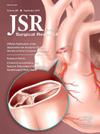Contemporary Analysis of Solid Pseudopapillary Neoplasms in Children Versus Adults
IF 1.7
3区 医学
Q2 SURGERY
引用次数: 0
Abstract
Introduction
Solid pseudopapillary neoplasm (SPN) comprises 2% of pancreatic tumors. We aimed to examine the clinical characteristics, management, and outcomes of SPN in children and adults using US-based national cancer registry data.
Methods
In this retrospective National Cancer Database analysis, children (<18 y) and adults (≥18 y) with SPN were included (2004-2020).
Results
A total of 1325 patients (231 children, 1094 adults) with SPN were identified. There were no differences between groups regarding tumor size, metastasis, or stage. Most patients in both groups underwent surgical treatment (96.5% versus 92.1%, P = 0.056), whereas a smaller proportion of children received chemotherapy compared to adults (0.9% versus 4.2%, P = 0.01). The 10-year overall survival rate was 99.1% in children versus 88.0% in adults. In multivariable Cox regression, when adjusted for tumor location and receipt of chemotherapy and radiation, adulthood (hazard ratio [HR]: 5.32, 95% confidence interval [95% CI]: 1.26-22.49, P = 0.02), Charlson-Deyo score ≥2 (HR: 3.04, 95% CI: 1.21-7.63, P = 0.02) compared to 0, stage II (HR: 2.48, 95% CI: 1.27-4.82, P = 0.008), stage III (HR: 6.82, 95% CI: 1.50-31.02, P = 0.01), and stage IV (HR: 5.94, 95% CI: 2.49-14.16, P < 0.001) compared to stage I were associated with an increased risk of mortality, whereas Hispanic compared to White patients (HR: 0.44, 95% CI: 0.21-0.95, P = 0.04) and surgically treated patients had a decreased risk of mortality (HR: 0.10, 95% CI: 0.05-0.21, P < 0.001).
Conclusions
Despite similar stage presentation, children with SPN exhibit prolonged survival compared to adults. Most patients underwent surgical treatment, whereas children were less likely to undergo chemotherapy than adults.
儿童与成人实性假乳头状瘤的当代分析。
简介:实性假乳头状肿瘤(SPN)占胰腺肿瘤的2%。我们的目的是使用美国国家癌症登记数据来检查儿童和成人SPN的临床特征、管理和结局。方法:在这项回顾性的国家癌症数据库分析中,共发现1325例SPN患者(231例儿童,1094例成人)。两组之间在肿瘤大小、转移或分期方面没有差异。两组中大多数患者接受手术治疗(96.5%对92.1%,P = 0.056),而儿童接受化疗的比例低于成人(0.9%对4.2%,P = 0.01)。儿童10年总体生存率为99.1%,成人为88.0%。在多变量Cox回归中,当调整肿瘤位置和接受化疗和放疗后,成年期(风险比[HR]: 5.32, 95%可信区间[95% CI]: 1.26-22.49, P = 0.02), Charlson-Deyo评分≥2 (HR: 3.04, 95% CI: 1.21-7.63, P = 0.02), II期(HR: 2.48, 95% CI: 1.27-4.82, P = 0.008), III期(HR: 6.82, 95% CI: 1.50-31.02, P = 0.01), IV期(HR: 5.94, 95% CI: 1.95 - 3.02)。2.49-14.16, P < 0.001)与I期相比,与死亡风险增加相关,而西班牙裔患者与白人患者相比(HR: 0.44, 95% CI: 0.21-0.95, P = 0.04)和手术治疗患者的死亡风险降低(HR: 0.10, 95% CI: 0.05-0.21, P < 0.001)。结论:尽管有相似的分期表现,但与成人相比,患有SPN的儿童表现出更长的生存期。大多数患者接受手术治疗,而儿童接受化疗的可能性低于成人。
本文章由计算机程序翻译,如有差异,请以英文原文为准。
求助全文
约1分钟内获得全文
求助全文
来源期刊
CiteScore
3.90
自引率
4.50%
发文量
627
审稿时长
138 days
期刊介绍:
The Journal of Surgical Research: Clinical and Laboratory Investigation publishes original articles concerned with clinical and laboratory investigations relevant to surgical practice and teaching. The journal emphasizes reports of clinical investigations or fundamental research bearing directly on surgical management that will be of general interest to a broad range of surgeons and surgical researchers. The articles presented need not have been the products of surgeons or of surgical laboratories.
The Journal of Surgical Research also features review articles and special articles relating to educational, research, or social issues of interest to the academic surgical community.

 求助内容:
求助内容: 应助结果提醒方式:
应助结果提醒方式:


